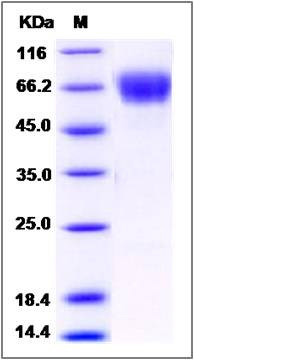Rat CLEC4F / CLECSF13 Protein
CLEC4F, Clecsf13, Kclr
- 100ug (NPP3019) Please inquiry
| Catalog Number | P80215-RNCH |
|---|---|
| Organism Species | Rat |
| Host | Human Cells |
| Synonyms | CLEC4F, Clecsf13, Kclr |
| Molecular Weight | The recombinant rat CLEC4F comprises 483 amino acids and predicts a molecular mass of 53.7 kDa. The apparent molecular mass of the recombinant protein is approximately 63-68 kDa in SDS-PAGE under reducing conditions due to glycosylation. |
| predicted N | Gly |
| SDS-PAGE |  |
| Purity | > 95 % as determined by SDS-PAGE |
| Protein Construction | A DNA sequence encoding the rat CLEC4F(NP_446205.1) (Arg70-Ser550) was expressed with two additional amino acids (Gly & Pro) at the N-terminus. |
| Bio-activity | |
| Research Area | Immunology |Signal Transduction |Cytoskeleton / ECM |Cell Adhesion |Lectin |C-tyep lectin | |
| Formulation | Lyophilized from sterile PBS, pH 7.4. 1. Normally 5 % - 8 % trehalose and mannitol are added as protectants before lyophilization. Specific concentrations are included in the hardcopy of COA. |
| Background | CLEC4F, a member of C-type lectins, was firstly purified from rat liver extract with high binding affinity to fucose, galactose and N-acetylgalactosamine, and un-sialylated glucosphingolipids with GalNAc or Gal terminus. However, the biological functions of CLEC4F have not been elucidated. Histochemical staining showed that mouse CLEC4F(mCLEC4F) is only expressed on F4/80+ cells localized in liver, and is undetectable in bone marrow, spleen, lymph nodes, or other tissues in adult mice. However, mCLEC4F is detected in the liver of embryonic day 11.5 (E11.5), which is 1.5 day earlier than the formation of liver (E10) and is 3.5 day earlier than the formation of bone marrow (E15-16). Moreover, recombinant mCLEC4F.Fc binds to alpha-galactoceramide in a Ca++-dependent manner, and both galactose and ceramide can partially inhibit CLEC4F.Fc binding to alpha-galactoceramide. Interestingly, mCLEC4F-deficient (mCEC4F k/o) mice produced far less cytokines than wild type littermates after intravenous injection ofalpha-galactoceramide. This suggests that mCLEC4F is not only a specific marker for Kupffer cells, but is also critical for the presentation of glycolipid antigen to NKT cells. |
| Reference |
